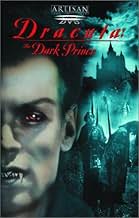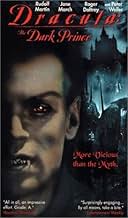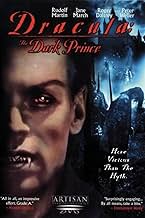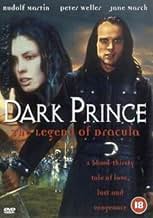NOTE IMDb
6,0/10
2,8 k
MA NOTE
Ajouter une intrigue dans votre langueThe dramatized story of Dracula, looking at the historic events rather than the Hollywood version.The dramatized story of Dracula, looking at the historic events rather than the Hollywood version.The dramatized story of Dracula, looking at the historic events rather than the Hollywood version.
- Réalisation
- Scénario
- Casting principal
- Récompenses
- 1 nomination au total
Avis à la une
I have always been fascinated by the history of Vlad Dracula, and am glad that someone finally decided to make a film of this fascinating man. Low budget or not, this film is a great interpretation of the history of the legend.
Not your typical Dracula film, this film tells the story of the real Dracula, who inspired the story by Bram Stoker. It shows his birth, to his reign as prince of Romania, to his death. Some of the scenes are based on fact, others, I'm sure, were written just for the film. I have quite a few historical books about the man, and yes, the atrocities shown in this movie, were in fact done by the man.
The film was filmed in Romania and Hungary, so that does add to the realism of the story. The film is low budget, but even so, the sword fights had excellent choreography, and the special effects were above par for the budget. The only drawback for me was the length. Only 90 minutes.
All in all, this movie is worth a rental by both historical buffs, and horror fans. Hopefully someone will make a big screen version of this story one day. It sure does deserve one.
Not your typical Dracula film, this film tells the story of the real Dracula, who inspired the story by Bram Stoker. It shows his birth, to his reign as prince of Romania, to his death. Some of the scenes are based on fact, others, I'm sure, were written just for the film. I have quite a few historical books about the man, and yes, the atrocities shown in this movie, were in fact done by the man.
The film was filmed in Romania and Hungary, so that does add to the realism of the story. The film is low budget, but even so, the sword fights had excellent choreography, and the special effects were above par for the budget. The only drawback for me was the length. Only 90 minutes.
All in all, this movie is worth a rental by both historical buffs, and horror fans. Hopefully someone will make a big screen version of this story one day. It sure does deserve one.
Some things...
1) Dracula's first wife (whose name has never been historically documented other than known to be a Transylvanian noblewoman) committed suicide in 1462, not 1464, when Dracula was already imprisoned by the King of Hungary anyway. Not sure why the film changed this, really.
2) The impalings... aren't accurate. The oiled stake is put in the buttocks and slowly moves out through the mouth. This takes days, the impalee dying a slow death. We don't see any actual impalings during the movie save one, and the guy slides down the stake like it's a flag pole.
3) While not necessarily portrayed as a nice guy, I was expecting a bit more brutality. Much of Vlad Tepes' acts are brushed aside in the framing story of Dracula being interrogated by the priests in 1476 as "stories" by Dracula himself and this just seems like a kind of cop-out. I realize we don't need to see Dracula cutting the breasts off of women and such, but there was PLENTY of more hard-hitting material that could have been put in there. Example: instead of Dracula just closing the doors and executing the boyars like he does in the film, wouldn't it be far more effective cinematically to follow what *really* happened and show Dracula and his men dragging the boyars to go and build (by themselves) Castle Dracula, which took years and basically worked the lot of them to death? Also would have been effective to show the scene of Dracula rounding up all the homeless and beggars into the grand hall, then having his men burn it to the ground. The only real story of Dracula that was included was the one with the golden goblet that wasn't touched by anyone... that's about it.
4) I realize it was done for dramatic purposes, but the film kept sticking Dracula's broth Radu in places/times he simply wasn't. Dracula was killed in 1476 by a man (a Turk) disguised as one of his own guards... in a MARSH somewhat near Snagov, not inside Snagov Chapel.
5) The ending is neither here or there... I'd rather they didn't go that route, but then the end of Vlad's life is a bit anti-climactic.
1) Dracula's first wife (whose name has never been historically documented other than known to be a Transylvanian noblewoman) committed suicide in 1462, not 1464, when Dracula was already imprisoned by the King of Hungary anyway. Not sure why the film changed this, really.
2) The impalings... aren't accurate. The oiled stake is put in the buttocks and slowly moves out through the mouth. This takes days, the impalee dying a slow death. We don't see any actual impalings during the movie save one, and the guy slides down the stake like it's a flag pole.
3) While not necessarily portrayed as a nice guy, I was expecting a bit more brutality. Much of Vlad Tepes' acts are brushed aside in the framing story of Dracula being interrogated by the priests in 1476 as "stories" by Dracula himself and this just seems like a kind of cop-out. I realize we don't need to see Dracula cutting the breasts off of women and such, but there was PLENTY of more hard-hitting material that could have been put in there. Example: instead of Dracula just closing the doors and executing the boyars like he does in the film, wouldn't it be far more effective cinematically to follow what *really* happened and show Dracula and his men dragging the boyars to go and build (by themselves) Castle Dracula, which took years and basically worked the lot of them to death? Also would have been effective to show the scene of Dracula rounding up all the homeless and beggars into the grand hall, then having his men burn it to the ground. The only real story of Dracula that was included was the one with the golden goblet that wasn't touched by anyone... that's about it.
4) I realize it was done for dramatic purposes, but the film kept sticking Dracula's broth Radu in places/times he simply wasn't. Dracula was killed in 1476 by a man (a Turk) disguised as one of his own guards... in a MARSH somewhat near Snagov, not inside Snagov Chapel.
5) The ending is neither here or there... I'd rather they didn't go that route, but then the end of Vlad's life is a bit anti-climactic.
I would like to see more Dracula movies based on the actual person. This is the first one I have ever come across. It's nice to see an interpretation on the real person rather than the Hollywood version. Though i wouldn't rely on this movie for true and accurate history, it did appear to stretch it for drama sake. The atmosphere is perfect, dark and haunting in a medieval sort of way. I thought it was amusing how at certain points the movie there were allusions to the common vampire myth (two i recall are about mirrors and driving a stake through Dracula's heart). Those point do spark interest into the real customs and beliefs of that time that formed the myth. I would recommend this movie to those who are at the least mildly interested in history and Dracula. Though it's a little dull at times and the brutality is dumbed down (it is a TV movie), it's a good movie to see when its on TV.
The movie deals with the so-called historical figure of Vlad Tepes (phonetically that is "Tzepesh" and it literally means "Impaler"), not the vampire of Bram Stoker but the tormented Wallachian (Romanian) medieval ruler that stood against the might of the Ottoman Empire with nothing but a few trained men of his own and his reputation as master of psychological warfare by means of sheer terror and unprecedented scale of prisoner execution through impalement (Google on that for detailed info). Vlad's father, also called Vlad, was a member of the Teutonic knightly order of the Dragon, which had been established in Germany with the purpose of protecting Christianity against the rise of Islam at the gates of Europe. His affiliation with this order gained him the surname "Dracul" which is a Romanian translation for "Dragon" and also a synonym for "devil". Vlad the Impaler, that is the son of Vlad Dracul, inherited his father's membership into the order of the Dragon, but because he was the son of Dracul, he was named "Draculea", or "Dracula", which means "son of Dracul", son of the Dragon, and ultimately son of the devil. His reputation as a mad executioner would be well justified by today's standards, although he was just a babe when compared to other rulers of his time (his own cousin, Stephen the Great, ruler of Moldavia, "the Athlete of Christ" as he had been named by the Pope for having repeatedly beaten the crap out of the Turks, had reportedly killed many more people through impalement than Vlad but because he had always been politically correct, he never went down into history as a deranged butcher). Vlad Tepes had the Saxons of Transilvania account for their transgressions against the conquered local Romanian population and it was because of the vengeful literate Germans who wrote exacerbated stories about him that he was later on remembered as the sadistic figure we now read of in the history books. He had also been ruthless with the breaking of the law in his own land. The only punishment instituted for whatever crime committed, regardless of its seriousness, was the one and only impalement. It's because of this that, during his reign, crime had reportedly dropped to nil. That is why, for the Romanians, he's still, up to this day, considered a national hero of special importance, unlike any other, because his name is called upon in times of great oppression, when corruption and plundering of the national economy by the oligarchic political class bring the common, ordinary citizens on their knees. When confronted with such disasters, Romanians cry out the verses of Mihai Eminescu (1850-1889), the greatest national poet of Romania, who had even written a poem in Tepes's honor which, in time, became a sort of a prayer for those crushed by the arrogance of the ruling class. In a few words, it goes something like this (in free translation):
"Where are you, lord Tepes / So that, by grabbing them / You would divide them in two packs: / Lunatics and scoundrels. / And in two large jails / You would forcibly gather them / And then set fire to the prison / And the madhouse."
(sounds much, much better in Romanian...lol :)))
"Where are you, lord Tepes / So that, by grabbing them / You would divide them in two packs: / Lunatics and scoundrels. / And in two large jails / You would forcibly gather them / And then set fire to the prison / And the madhouse."
(sounds much, much better in Romanian...lol :)))
The biggest reason why i love this movie so much because im from Balkan and Romania is my neighboring country and they are also Orthodox like myself. But thats not the only reason of course, movie was just wonderful (even thought it had low budget), Rudolph Martin was also great, location and music everything, I just loved it so much. The only problem i saw was the cover of the movie. Its very misleading, because this movie is definitely not about bloodsucking creatures, its about a Prince who would do anything to bring justice to his people and his country, even become a catholic, and his actions were seen as fight against God and his soul was condemned forever. Its a must see, especially for the people of Orthodox orgins.
Le saviez-vous
- AnecdotesIn 2000, to promote the film's premiere, USA Network held a sweepstakes contest with a grand prize of $5,000 to the lucky person who can correctly identify five myths of Dracula as depicted in this film.
- Citations
Radu: You are going to kill me, aren't you?
Vlad Dracula: You are a traitor to your people. You betrayed our father!
Radu: I never betrayed our father! Besides, if it weren't for me, you'd still be in that Turk prison.
Vlad Dracula: You had that much influence over the Sultan? Even as a boy?
Radu: Especially as a boy.
- Bandes originalesLa Scarpa My Faict Mal
Written by Bernard Solomon (as J. Baird) and Frank Gari (as F. Gari)
Meilleurs choix
Connectez-vous pour évaluer et suivre la liste de favoris afin de recevoir des recommandations personnalisées
Détails
- Date de sortie
- Pays d’origine
- Langue
- Aussi connu sous le nom de
- Dracula: The Dark Prince
- Lieux de tournage
- Sociétés de production
- Voir plus de crédits d'entreprise sur IMDbPro
Contribuer à cette page
Suggérer une modification ou ajouter du contenu manquant

Lacune principale
By what name was Dark Prince: The True Story of Dracula (2000) officially released in Canada in English?
Répondre


























